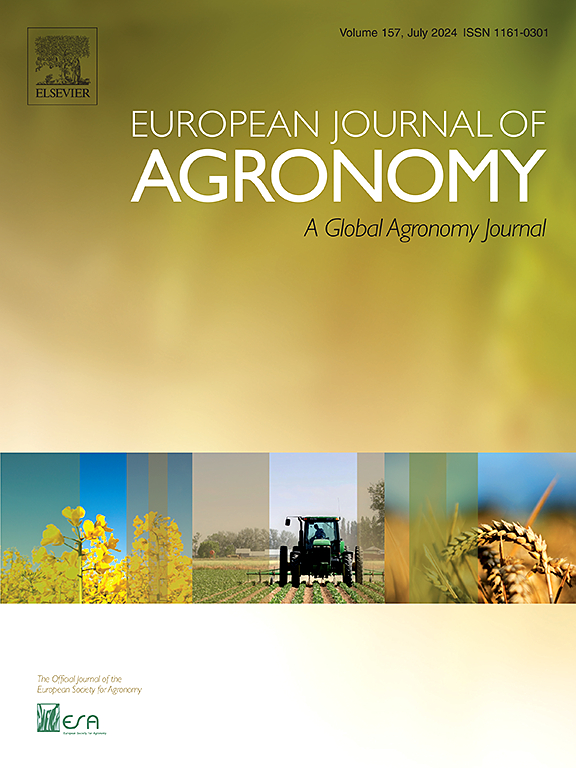Impact of fertilizer applications on grain and vegetable crops in smallholder Mixed Crop-Livestock (MCL) systems in West Africa
IF 5.5
1区 农林科学
Q1 AGRONOMY
引用次数: 0
Abstract
Mixed crop-livestock (MCL) systems can enhance crop yield, and improve nutrient cycling while reducing chemical fertilizer use. However, only a limited number of studies that reported this assumption were conducted under real-world conditions of small-scale farmers or followed an integrated approach. A survey was conducted in the 2021/2022 and 2022/2023 cropping seasons in Ghana and Burkina Faso, respectively, to determine the impact of fertilizer application practices on the yield of grain and vegetable crops in real-world MCL systems. Detailed information on fertilizer management practice and yield was collected from 317 MCL system farms distributed across three (3) districts/provinces in the Upper East region of Ghana and over the Plateau central of Burkina Faso, respectively summarising data on their grain and vegetable yields under (1) major fertilizer sources; organic, chemical, and combined (organic + chemical), (2) N fertilizer rate (crop x country specific N kg ha−1 recommendation), (3) application timing of fertilizer sources (recommended crop x country specific time of application), and (4) fertilizer placement methods (broadcast versus side placement versus furrow). Results show that the use of different fertilizer source increased (P < 0.05) yields of all grain crops (in Burkina Faso) and maize, rice, sorghum, millet, cowpea and all vegetable crops (in Ghana). The application of crop and country specific recommended N rates significantly influenced (P < 0.05) yields of sorghum, cowpea and green beans in Burkina Faso and rice, sorghum, millet, cowpea and pepper in Ghana compared to low N application rates. The contribution of manure application and appropriate timing on yield mostly differed between countries, such that high tendencies of increased yields were recorded when manure was applied for 0–3 weeks before planting (WBP) in Burkina Faso, while in Ghana, the highest yield improvements were observed when application periods exceeded 3 WBP. Not broadcasting chemical fertilizer only increased (P < 0.05) yields of millet and green beans (in Burkina Faso) and vegetable crops in both countries. These results help improve our understanding of fertilizer practices in mixed crop-livestock systems of Burkina Faso and Ghana, and may help guide recommended fertilizer management in MCL systems of these countries and similar ecologies in West Africa.
西非小农混合作物-畜牧业(MCL)系统施肥对粮食和蔬菜作物的影响
混合作物-牲畜(MCL)系统可以提高作物产量,改善养分循环,同时减少化肥的使用。然而,只有少数报告这一假设的研究是在小农的现实条件下进行的,或者采用了综合方法。研究人员分别于2021/2022年和2022/2023年在加纳和布基纳法索进行了一项调查,以确定实际MCL系统中施肥做法对谷物和蔬菜作物产量的影响。从分布在加纳上东部地区三(3)个区/省和布基纳法索中部高原地区的317个MCL系统农场收集了有关肥料管理实践和产量的详细信息,分别总结了(1)主要肥料来源下的粮食和蔬菜产量数据;有机,化学和组合(有机+化学),(2)氮肥用量(作物x国家特定N kg ha - 1推荐),(3)肥料来源的施用时间(推荐作物x国家特定施用时间),以及(4)肥料施用方法(撒播,侧施,沟施)。结果表明,不同肥料源的使用提高了所有粮食作物(布基纳法索)和玉米、水稻、高粱、谷子、豇豆和所有蔬菜作物(加纳)的产量(P <; 0.05)。与低施氮量相比,施用作物和国家特定推荐施氮量显著影响布基纳法索高粱、豇豆和四季豆以及加纳水稻、高粱、小米、豇豆和胡椒的产量(P <; 0.05)。施用肥料和适当的时间对产量的贡献在各国之间大多不同,例如,在布基纳法索,在播种前0-3周施用肥料时记录到产量增加的高趋势,而在加纳,当施用时间超过3周时,观察到产量的最高提高。不施化肥只增加了两国谷子、青豆(布基纳法索)和蔬菜作物的产量(P <; 0.05)。这些结果有助于提高我们对布基纳法索和加纳混合作物-牲畜系统施肥做法的理解,并可能有助于指导这些国家MCL系统和西非类似生态系统的推荐肥料管理。
本文章由计算机程序翻译,如有差异,请以英文原文为准。
求助全文
约1分钟内获得全文
求助全文
来源期刊

European Journal of Agronomy
农林科学-农艺学
CiteScore
8.30
自引率
7.70%
发文量
187
审稿时长
4.5 months
期刊介绍:
The European Journal of Agronomy, the official journal of the European Society for Agronomy, publishes original research papers reporting experimental and theoretical contributions to field-based agronomy and crop science. The journal will consider research at the field level for agricultural, horticultural and tree crops, that uses comprehensive and explanatory approaches. The EJA covers the following topics:
crop physiology
crop production and management including irrigation, fertilization and soil management
agroclimatology and modelling
plant-soil relationships
crop quality and post-harvest physiology
farming and cropping systems
agroecosystems and the environment
crop-weed interactions and management
organic farming
horticultural crops
papers from the European Society for Agronomy bi-annual meetings
In determining the suitability of submitted articles for publication, particular scrutiny is placed on the degree of novelty and significance of the research and the extent to which it adds to existing knowledge in agronomy.
 求助内容:
求助内容: 应助结果提醒方式:
应助结果提醒方式:


